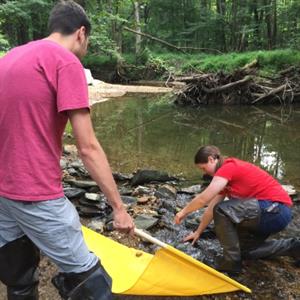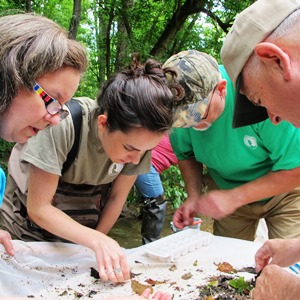Scott Maxham, IWLA Clean Water Fellow
There are countless ways to assess the health of a stream, from chemical tests to growing bacteria in petri dishes. The Izaak Walton League finds sampling benthic aquatic macroinvertebrates to be an accurate indicator of stream health – one that any citizen scientist can tackle.
Much as foresters judge a forest by its diversity of trees, we judge streams by the diversity of life within it. Benthic aquatic macroinvertebrates spend months – even years – living in the same spot in a stream. What exactly are they?
- Benthic: lives in the bottom of a stream
- Aquatic: lives in the water and has gills (at least for the larval stage)
- Macro: large enough to see with the naked eye (as opposed to a microscope)
- Invertebrate: no backbone
 Benthic aquatic macroinvertebrates sampling – it’s a mouthful. To save ink (and our voices during trainings) we usually refer to these critters as “macros” or “bugs.” At its most basic level, “sampling” for macros is merely turning rocks over and kicking up the streambed to dislodge the macroinvertebrates into a net. Next we identify and count them. Unlike many other sampling programs, we return our critters back into the stream. As conservationists, we think it’s important to put these organisms back where they were found – at the very least, they become quick fish food!
Benthic aquatic macroinvertebrates sampling – it’s a mouthful. To save ink (and our voices during trainings) we usually refer to these critters as “macros” or “bugs.” At its most basic level, “sampling” for macros is merely turning rocks over and kicking up the streambed to dislodge the macroinvertebrates into a net. Next we identify and count them. Unlike many other sampling programs, we return our critters back into the stream. As conservationists, we think it’s important to put these organisms back where they were found – at the very least, they become quick fish food!
We wanted to dispel a few myths about macro monitoring and let you know why you should wade in with us!
What the heck are these “macros”?
You may be surprised to find that you already know many of these critters. Dragonflies, Mayflies, Black flies, crayfish, and snails are all examples!
Why don’t you just count fish instead?
- Electrofishing can be expensive and requires hard-to-get permits. Furthermore, it is not a skill that citizen scientists can easily learn. Identifying macros can be learned in a day (and perfected over a lifetime). We prefer to count the fish we catch the old fashioned way – with a hook and line!
- Fish can be a great indicator of stream health, but they have the advantage of mobility. The bugs we look for generally stay in the same spot their whole life. This allows us to assess a specific area of a stream year after year.
Why can’t you just send stream water to a lab?
We could, and many people do this. We prefer our methods for several reasons:
- Cost. We can buy a net for about $40 and it will last several years. Just one lab test costs more than that!
- Speed. We immediately get results after an hour or two of looking for macros.
- Fun! For us, scooping up a vial of water doesn’t count as quality outdoor time. We prefer putting on our waders, splashing into a stream, and scooping up the critters we find there. It’s much more of an adventure, allows you to learn more about your stream, and provides more time outside.
It’s kind of gross to look at bugs.
Most kids would disagree with that, but handling bugs can be an acquired skill. I still squirm a little when I pick up fat cranefly larvae, and I always use a spoon or tweezers to pick up pinching hellgrammites. But we aren’t asking you to pick up venomous snakes here! These critters are not dangerous. Most stream monitors start with tweezers, not their fingers, to sort through debris and collect bugs. And keep in mind that some of those bugs will one day transform into beautiful dragonflies!
 Why do I have to count a bunch of tiny bugs?
Why do I have to count a bunch of tiny bugs?
It certainly takes time and some patience. I would be lying if I said it is fun to count 100 flatworms. Some streams are full of diversity some are not. It is important to keep the end goal in mind: counting these bugs helps us identify pollution problems and healthy streams.
It seems like this work should be done by professionals.
And it is! But there is simply not enough funding at the state and local levels to dispatch trained biologists to monitor every stream in the country. The data volunteers gather can be used to identify problem areas and alert the proper authorities.
Why can’t we just monitor the streams that are degraded?
We can’t know which ones are healthy until we start monitoring them. When we do find a healthy stream, that’s just as important. Documenting that a stream is clean is helpful in case pollution problems pop up later.
Sampling our waterways is a great way to not only understand the health of our waters but also to understand how our use of the land around them affects water quality. We all affect these waters – for better or worse. We don’t all fish or swim in our creeks, but the overwhelming majority of us rely on clean streams for drinking water and much of the food we enjoy!
For more tips on identifying aquatic macroinvertebrates, check out our free Aqua Bugs app!